For their ‘Rare Watches’ auction on November 8, 2021 in Geneva, Christie’s was entrusted with the sale of an exceptional piece of Rolex history – a super elusive Rolex Deep Sea Special – but not just any – the actual Numero Uno, “the very first prototype” which according to the auction house’s own words was attached to the outside of the legendary bathyscaphe Trieste when it descended to a record depth of 3,150 meters on September 30, 1953. Given its historical importance, the specialists at Christie’s set the estimate between 2,000,000 and 4,000,000 Swiss Francs but insiders reckon the owner is aiming for a much higher figure, perhaps even double the high estimate.
Sounds like a serious collector’s piece… but is it true what the auction house claims – assisted by the usual mainstream watch media suspects? Is Christie’s Deep Sea Special No. 1 really the watch that made the record dive in 1953? NOT according to Rolex, that is for sure! A closer look at the publicly available data on these obscure experimental pieces revealed the watch is a later model which, according to people familiar with it, probably never dipped a lug in the ocean. The watch is said to have survided great depths but how will it hold up in a forensic deep dive under the Perezcope? Continue reading to get the full historical picture…
…or go straight for the main course.
What is a Rolex Deep Sea Special?
The Rolex Deep Sea Special (DSS) was an experimental Oyster model with distinct bubble crystal created to withstand ocean floor pressures equivalent to several tons per square inch. Three different models were made over the span of ten years. On January 23, 1960, the final iteration reached the deepest point on the planet attached to the outside of a special submersible known as bathyscaphe Trieste.
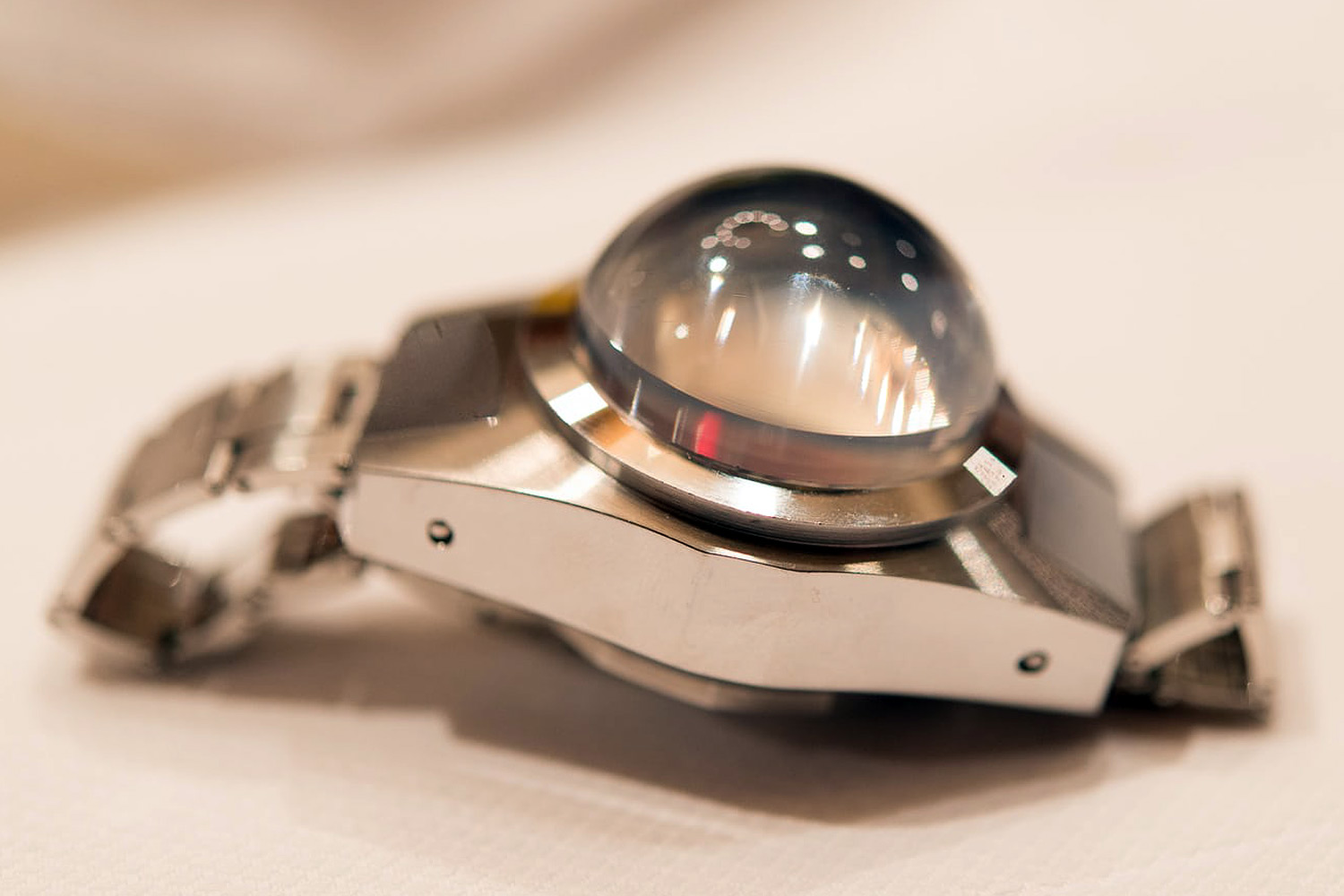
As of today, three pieces said to have participated in actual deep dives are known. In addition, Rolex produced at least 47 commemorative pieces after 1960 which were presented to museums and top retailers around the globe. In 2010, Rolex provided the following timeline.

Download: Celebrating 50 years of underwater heritage (Rolex, JPG)
The Bathyscaphe ‘Trieste’
Between 1946 and 1948, Swiss scientist and explorer Auguste Piccard, famous for his 1930s record altitude flights in a helium-filled balloon, developed a “diving balloon” named FNRS-2 capable of withstanding pressures equivalent to 13,000 ft/4,000 m of depth. The “abyssal submarine” consisted of a float filled with lighter-than-water gasoline for buoyancy and a pressure sphere for a crew of two.

Named after the Belgian ‘Fonds National de la Recherche Scientifique’ which funded the project, FNRS-2 was the first prototype of a ‘bathyscaphe’ (ancient greek for deep-boat). The concept dated back to 1938 but the outbreak of World War 2 significantly delayed Piccard’s plan. In October 1948, after a first unmanned test dive off Dakar, West Africa, the float was badly damaged on the surface as a result of a rough sea. FNRS-2 was not the seaworthiest of vessels. In 1950, the damaged prototype was taken over by French Navy. Rebaptised FNRS-3, the French rebuilt the submersible with ‘scientific advise’ from Piccard, but unhappy with his subordinate role, the Swiss inventor withdrew from the project when local industrialists from Trieste, Italy, offered him the chance – as physicist-engineer in chief – to build his own bathyscaphe.
It was in this pioneering environment that Rolex decided to go a step further and cement the Oyster as the ultimate dive watch. While the depth rating of the upcoming Rolex Submariner models would limit the watches to the continental shelf (<660 ft/200 m), a new experimental Oyster was to demonstrate Rolex’s capability to go way beyond and withstand average ocean depths (~12,100 ft/3,688 m) or even more. To reach these depths, the Swiss company naturally teamed up with the famous Swiss explorer.
The cigar-shaped float of Piccard’s new bathyscaphe was built in Trieste, Italy, hence the name chosen for the vessel. The pressure cabin was made at Terni, about 100 km north of Rome. Consisting of two hemispheres made of forged steel on one of the world’s largest steel presses, the cabin could theoretically withstand depths of 9 to 10 miles beneath the sea.

The bathyscaphe Trieste was launched on August 1, 1953 into the Mediterranean Sea at Castellammare near Naples where the final assembly had taken place. After a series of preliminary shallow dives, the Trieste was ready for its first real challenge. On August 26, 1953, Auguste Piccard and his son Jacques took the bathyscaphe down to 3,543 ft/1,080 m off the coast of Capri. One month later, the Trieste was towed by tug boat near the island of Ponza where it descended to a much deeper part of the Mediterranean Sea. After touching the sea floor, the instruments aboard measured a depth of 10,334 ft/3,150 m – more than tripple the original depth record set by William Beebe in his steel cable-borne ‘Bathysphere’ on August 15, 1934 (3,028 ft/923 m).

By the way, see those dark lines on the float? They mark the different gasoline compartments. In case of a leak, it would be immediately visible which section was damaged.
According to Rolex, a “special Oyster” watch was strapped to the outside of the bathyscaphe during these dives.
“1953 – In tandem with dives carried out by the Trieste, a second version of the Deep Sea Special – even more solid and robust than the first – is strapped to the outside of the bathyscaphe and successfully tested at 1,080 metres. It is submerged to 3,150 metres later the same year. When not being tested, the watch is stored in a specially made wooden box, with an instruction sheet detailing how to wind and set the watch tacked to the inside of the lid.
1956 – The same prototype finally reaches a depth of 3,700 metres during a new dive of the Trieste.”
During the dives, the watch was fastened to the ladder at the end of the entrance tunnel leading to the pressure sphere. Since this tube was completely flooded during the dives, the watch was exposed to full ocean depth pressure while at the same time being protected from wave action. (Thank you Mr. Don Walsh for sharing this interesting piece of information with me.)

In Auguste Piccard’s book Earth, Sky and Sea published in April 1956 there is no mentioning of a particular Rolex watch but at the end of the book, Professor Piccard expressed his gratitude to a series of entities, among them “Rolex S.A. (Geneva)”.
In 2010, Rolex celebrated the 50th anniversary of their record dive to the deepest point in the ocean in tandem with the bathyscaphe Trieste. The company stated the first experimental Oyster intended to resist great depths was created in 1950 and successfully tested by “expert divers”. In 1953, Rolex developed a “more solid and robust” version which withstood the record depth of 3,150 m/10,330 ft attached to the outside of Piccard’s bathyscaphe. In 1960, “using the knowledge gained from making the first two models”, a third model, “created to withstand the most extreme conditions”, reached ‘Challenger Deep’, the deepest point in the ocean at 35,797 ft/10,911 m.

It becomes clear Rolex created three different models of the Deep Sea Special over the course of time.
DSS No. 1 Surfaces in 2005
The quirky Deep Sea Special No. 1 entered the collector’s market through a Christie’s auction in November 2005. This was not the first time the auction house had seen such an unconventional piece.
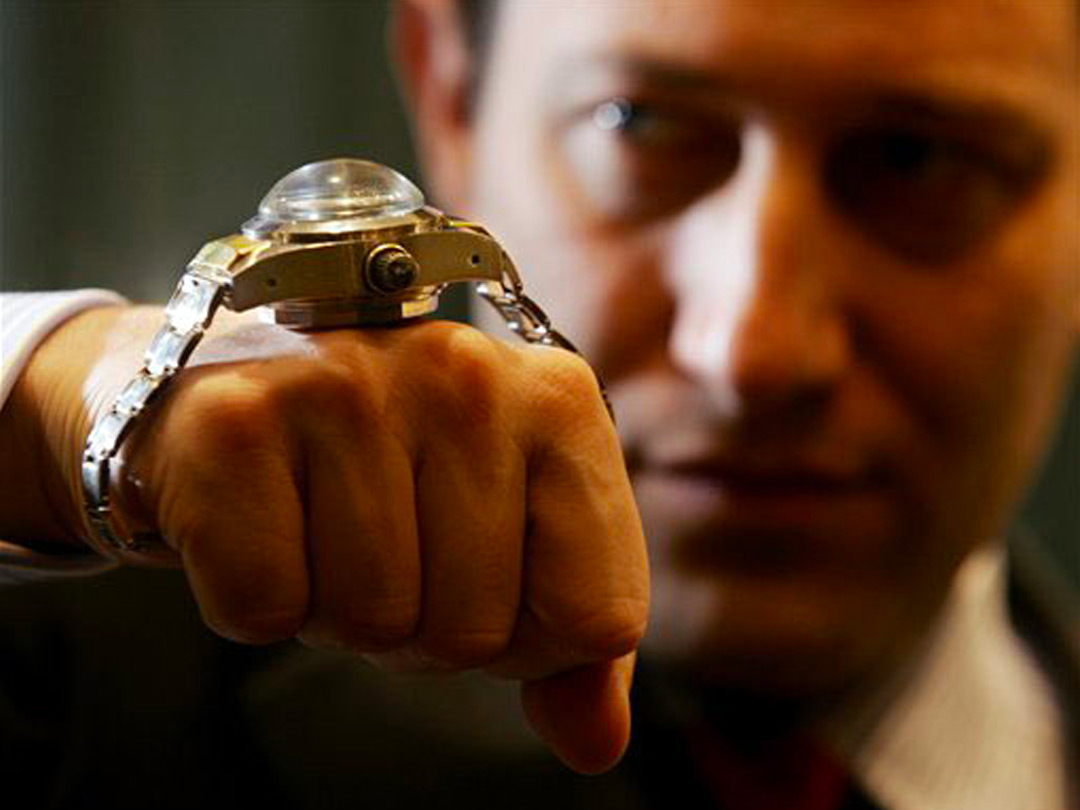
Five years earlier, in June 2000, Christie’s had auctioned an almost identical piece – the Deep Sea Special No. 5. The main difference between the two is a considerably lower bubble crystal on No. 1.
Past auction link: Rolex Deep Sea Special No. 5 (Christie’s, June 2000)
Past auction link: Rolex Deep Sea Special No. 1 (Christie’s, Novemenber 2005)
Current auction link: Rolex Deep Sea Special No. 1 (Christie’s, November 2021)
The Deep Sea Special No. 1 was consigned to Christie’s by an elderly lady whose deceased husband was in some way related to Rolex and had been gifted the roly-poly watch by Rolex founder Hans Wilsdorf. Nowhere in Christie’s description it was stated that the Deep Sea Special No. 1 was the actual watch that made it down to 10,330 ft/3,150 m in late 1953. It was only said the watch participated in one of Piccard’s diving trials in the Mediterranean Sea:
According to its owner, the present watch participated at one of Picccard’s diving trials with the bathyscaph “Trieste” in the Mediterranean Sea.
Years later, people made false assumptions based on insufficient research and thus it became accepted that the Deep Sea Special No. 1 was the record watch from 1953. Besides featuring the No. 1 on the caseback, the lower crystal lead people to believe, it was designed to withstand less pressure than the Deep Sea Special No. 3 that reached the bottom of the Mariana Trench in 1960.

Speaking of crystal, see how badly dented the edge of the crystal of the DSS No. 1 is? Keep this in the back of your mind for later.

The cases of the DSS No. 1 and the DSS No. 3 are identical in shape and size. Both have the very same crown construction with the extra ring. The tall crystal of the DSS No. 3 causes an awkward magnification and visual distortion of the dial whereas the dial of the DSS No. 1 shows almost no signs of distortion.

In July 1954, ‘The National Geographic Magazine’ published a big story on the conquest of Mount Everest. Additionally, there was also a story by Jacques Cousteau about the French bathyscaphe FNRS-3 which had just obliterated Piccard’s depth record on February 15, 1954 when it descended to 13,287 ft/4,050 m off Dakar, West Africa. Rolex took the opportunity to place one of their most iconic ads which celebrated the fact that Mount Everest and the ocean floor had been conquered in the very same year – 1953 – and that Rolex had been present at both events.

In this ad, Rolex presented the “special Oyster” which set the record on September 30, 1953. To make it look like a regular Rolex Submariner, which had just been introduced to the market, the advertising agency manipulated the photo by adding a rotating bezel from a Rolex Turn-O-Graph and a smaller, more commercial crown.

Let’s bring this watch to life by adding a bit of colour and see how it compares to the DSS No. 1. A good point of reference to put them into relation is the size of the bracelet. Clearly, the watch from the 1954 ad is considerably smaller than the DSS No. 1 (38 mm vs. 43 mm). Note also the dial which appears much more distorted under the glass. This is super profound as it suggests the watch from the 1954 Rolex ad had a taller crystal than the DSS No. 1.

Another notable difference are the hands. The watch on the left had so-called ‘sword’ hands whereas the DSS No. 1 has ‘pencil’ hands. Interestingly, all exhibition pieces made after 1960 have ‘sword’ hands. One particular detail literally screams ‘1953’ – the lollipop-style seconds hand which can also be found on the earliest Rolex Submariner and Turn-O-Graph models that were launched in the second half of 1953. There is no doubt, the watch from the 1954 National Geographic ad features pure 1953 design language.

The very same watch, although in unedited condition without the 60-minute bezel and smaller crown, was depicted as part of an extensive article on the developement of ‘bathyscaphe’ watches published by Rolex in the British Horological Journal from March 1954.

The above article offers lots of insight, some of which will be discussed later. At this point, the important thing to focus on is the watch at the bottom captioned:
“This is the special Rolex that stood up to a pressure of 8,820 pounds per square inch.”
8,820 pounds per sq. inch is equivalent to 600 atm/cm2 which is almost double the depth reached on September 30, 1953. A comparison with the DSS No. 1 shows it is a considerably different watch.

In 1959, Rolex released a brochure to present their factory and the steps involved in the production of Rolex watches. One of the pages is of special interest as it shows an operator working on a massive water resistance testing machine and next to him on the working bench, an empty ‘bathyscaphe’ watch case. On the right-hand side of the page, Rolex depicted yet again the very same watch and referred to it as the record watch from 1953.

Rolex stated:
“On the right is the famous Rolex OYSTER which was fitted to the outside of Professor Piccard’s bathyscaphe which dived to a record depth of 10,335 ft, where pressure is almost two tons per sq. inch.”
Let’s compare this watch to the DSS No. 1. Same result, obviously.

So here we have Rolex showing us the watch that went down to 10,330 ft/ 3,150 m in 1953, not once but three times over the course of five years (1954 – 1959) and it is definitely not the DSS No. 1.
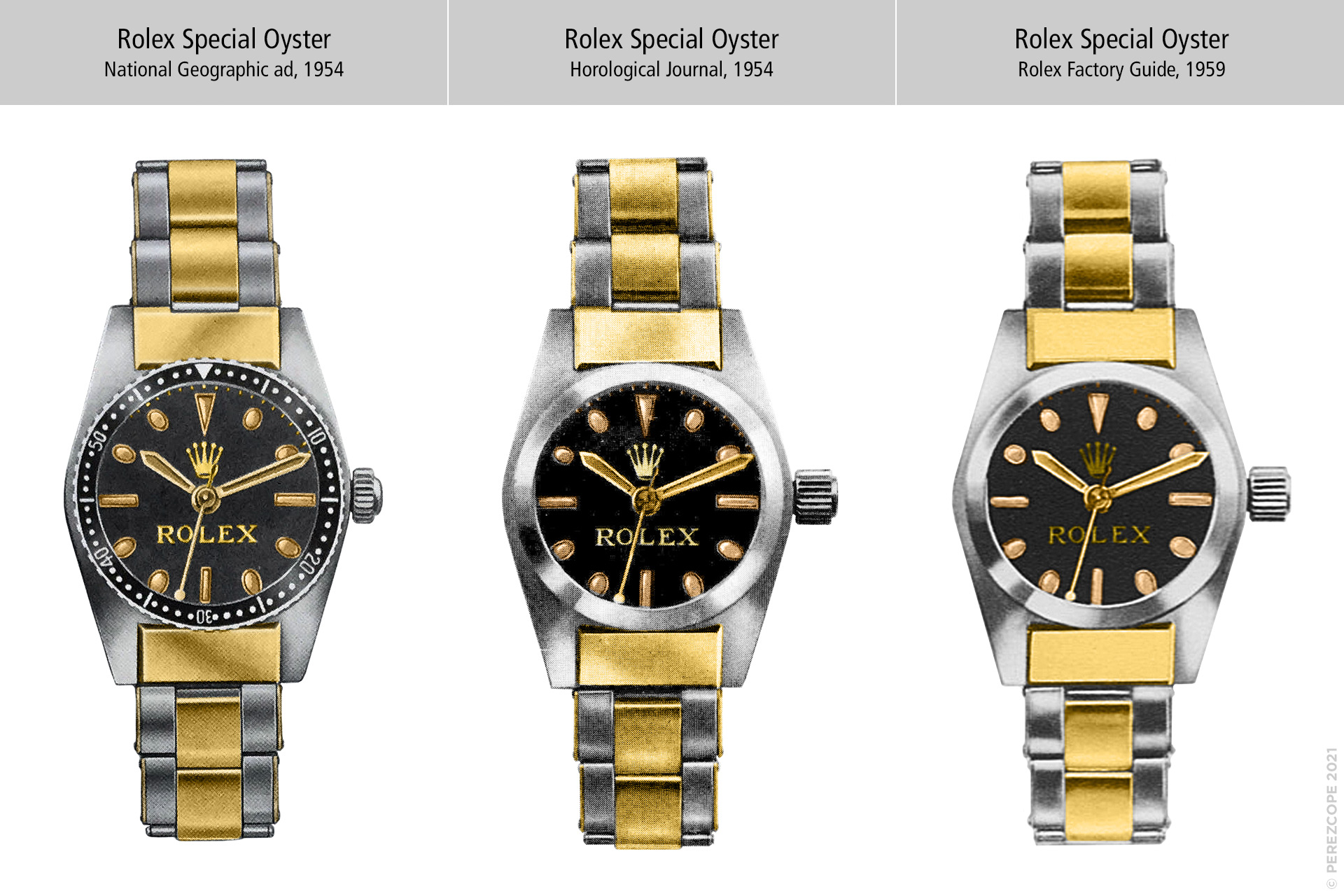
The next photo, taken between August 1953 and August 1957 at Castellammare, Italy, shows Jacques Piccard holding a ‘bathyscaphe’ watch in his hands. It was always assumed this was the DSS No. 1, despite looking very small.

Jacques Piccard was a very tall man (6.5 ft/1.98 cm). Could it be that the watch appears small because of his size? Not really, as the following comparison demonstrates. Placed next to a photo of Don Walsh from 2012 in which the former Navy man was holding his own commemorative Rolex Deep Sea Special (ø 43 mm), it becomes evident the watch in Jacques Piccard’s hands is considerably smaller, and definitely not the DSS No. 1.

There are more interesting details to talk about. For instance the movement.
Cal. 1000 Movement
The article on the development of the Rolex Deep Sea Special from 1954 stated the record watch had a 10 ½ ligne movement. That is a small-sized movement (ca. 23,7 mm) and suggests it was a manual winding caliber.
The watch, a wrist watch with a 10 ½ ligne movement, withstood extremely high pressure during the two and a quarter hours that the bathyscaphe was beneath the surface.
The following passage from the same article is further indication that it was indeed a manual movement.
“The inside of the case-back was deeply pitted with marks of the screws and pinions of the movement where they had been forced against the case.”
From a logical point of view, if the movement had a rotor and an automatic bridge, the screws and pinions could not have touched the inside of the caseback. In addition, in their communication from 2010, Rolex said the 1953 record watch was stored in a special wooden box, with an instruction sheet detailing how to wind and set the watch.
The next picture shows what a Rolex 10 ½ ligne caliber from 1953 looks like. Note that the watch itself has a diameter of 34 mm.

The DSS No. 1 on the other hand is powered by a self-winding movement (automatic). Marked 1000 on the automatic bridge, the caliber is actually based on Cal. 1030 (marked 1030 on the main plate) but appears to be a lesser version with 21 in lieu of 25 jewels. The diameter of Cal. 1030 was no longer measured in linge but in millimeters, 28.5 mm. The same caliber 1000 can also be found in Rolex Oysterdate Perpetual Ref. 6518 models with case numbers from 1955.
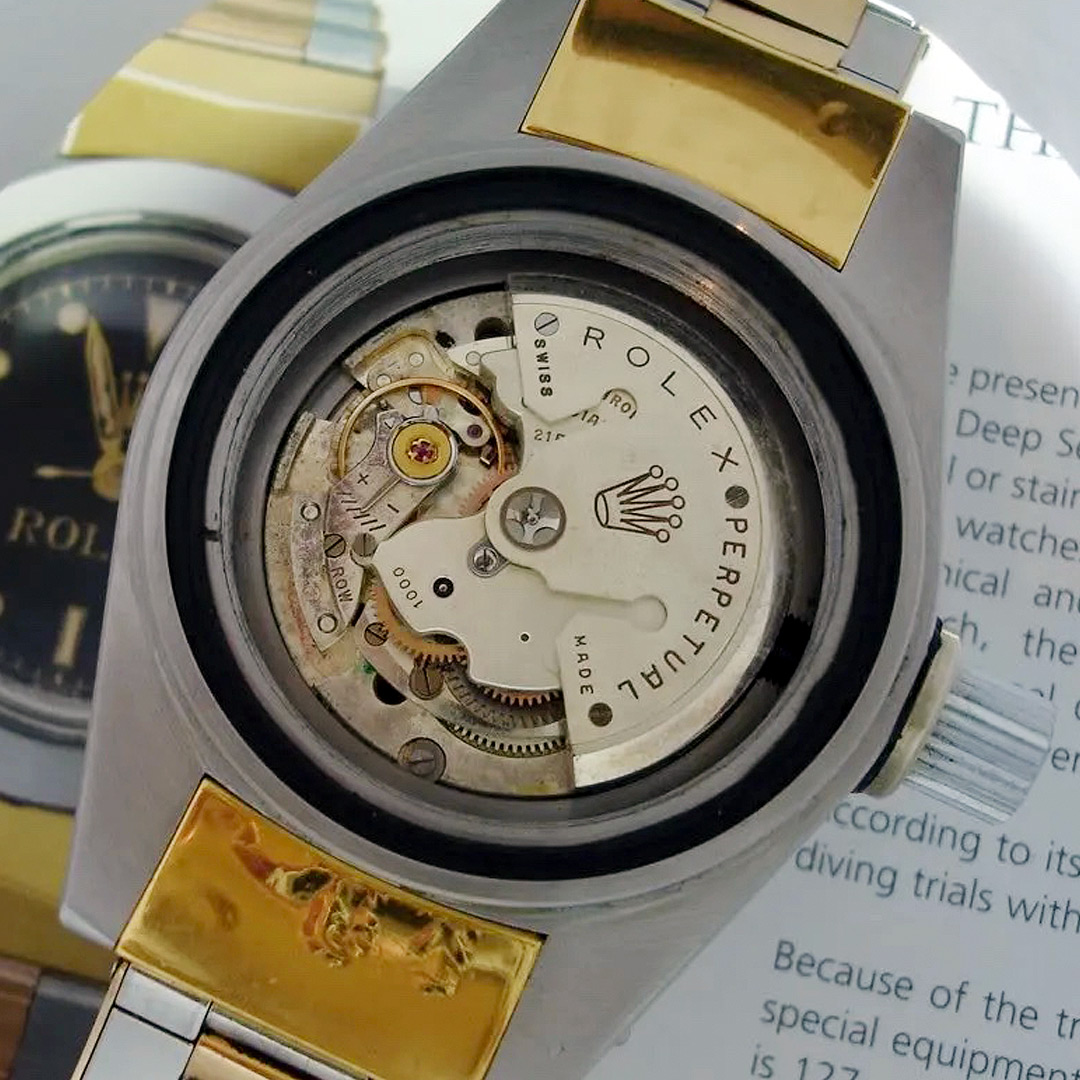
The most interesting detail of this movement is the ‘ROW’ stamp on the balance cock. “ROW’ was Rolex’s very own import code for the United States. Since 1930, all ‘adjusted’ movements imported to the U.S. from Switzerland became subject to tarifs which led to a lot of smuggling. In 1936, it was decided that all movements entering the U.S. from Switzerland had to be permanently marked with a three-letter code that identified the importer. Unadjusted movement were exempted from this rule. In 1953, the Piccards were the only ones conducting this type of deep dives which took place exclusively in the Mediterranean Sea, far away from the States. In addition, not a single part of the Trieste came from the U.S. An American import code in 1953 makes absolutely no sense!
But this is where it gets interesting. In Spring 1955, Jacques Piccard went to London to lecture at the Royal Society of Arts. There he met Dr. Robert Dietz, an oceanographer working for the United States Navy’s Office of Naval Research (ONR) who expressed great interest in the bathyscaphe. After personally inspecting the Trieste at Castellammare a few weeks later, Dietz began promoting the submersible in U.S. Navy circles. In February 1957, the ONR offered to fund a series of dives off Naples, Italy to evaluate the craft. A group of American oceanographers and underwater sound specialists travelled to Castellammare in summer 1957, eventually recommending the submersible be acquired by the United States government. It was during these tests that Dr. Robert Dietz first talked about a possible assault on ‘Challenger Deep’, the deepest depression in the world. In January 1958, the U.S. Navy acquired the Trieste for USD 200,000 and after a long trip aboard the USS Antares, the bathyscaphe arrived at her new base, the Navy Electronics Laboratory (NEL) at San Diego on August 23, 1958.
The bathyscaphe was then reconditioned with a bigger and heavier pressure sphere made by Fried. Krupp in Germany which required the float to be larger as well. It was in this configuration that Jacques Piccard and U.S. Navy Lieutenant Don Walsh reached the bottom of the Mariana Trench on January 23, 1960.

In their 50th anniversary pamphlet of the 1960 Mariana Trench dive, Rolex wrote:
“1960 – Using the knowledge gained from making the first two models, the third Deep Sea Special is created to withstand the most extreme conditions. This is the watch that, when strapped to the bathyscaphe Trieste, is found to be in perfect working order after reaching the Challenger Deep portion of the Mariana Trench, 10,918 metres below the surface of the sea.”
For their assault on ‘Challenger Deep’, Rolex created a third iteration. As I understand it, they produced a completely new model and not just a taller crystal! Since the DSS No. 1 has the exact same case as the DSS No. 3 from the Smithsonian, it is almost certainly a watch created after the arrival of the Trieste to the U.S. in August 1958. In this context, the ‘ROW’ code on the balance cock suddenly starts making sense.
In mid September 1960, Rene Denton, President of The American Rolex Watch Corporation, presented the Rolex Deep Sea Special Nr. 3 to the Secretary of the Smithsonian Institution, Leonard Carmichael. Soon after, Rolex began advertising the world record dive. The watch shown in the advertisements had a white dial just like the DSS Nr. 3 but different end links (same as the DSS Nr. 1/5).

For some reason the watch was missing the seconds hand. From what I heard, this very example is in the Rolex archives in Geneva and could either be Nr. 2 or 4. The following is an overview of all known third generation Rolex Deep Sea Special examples made between 1958 and 1960.
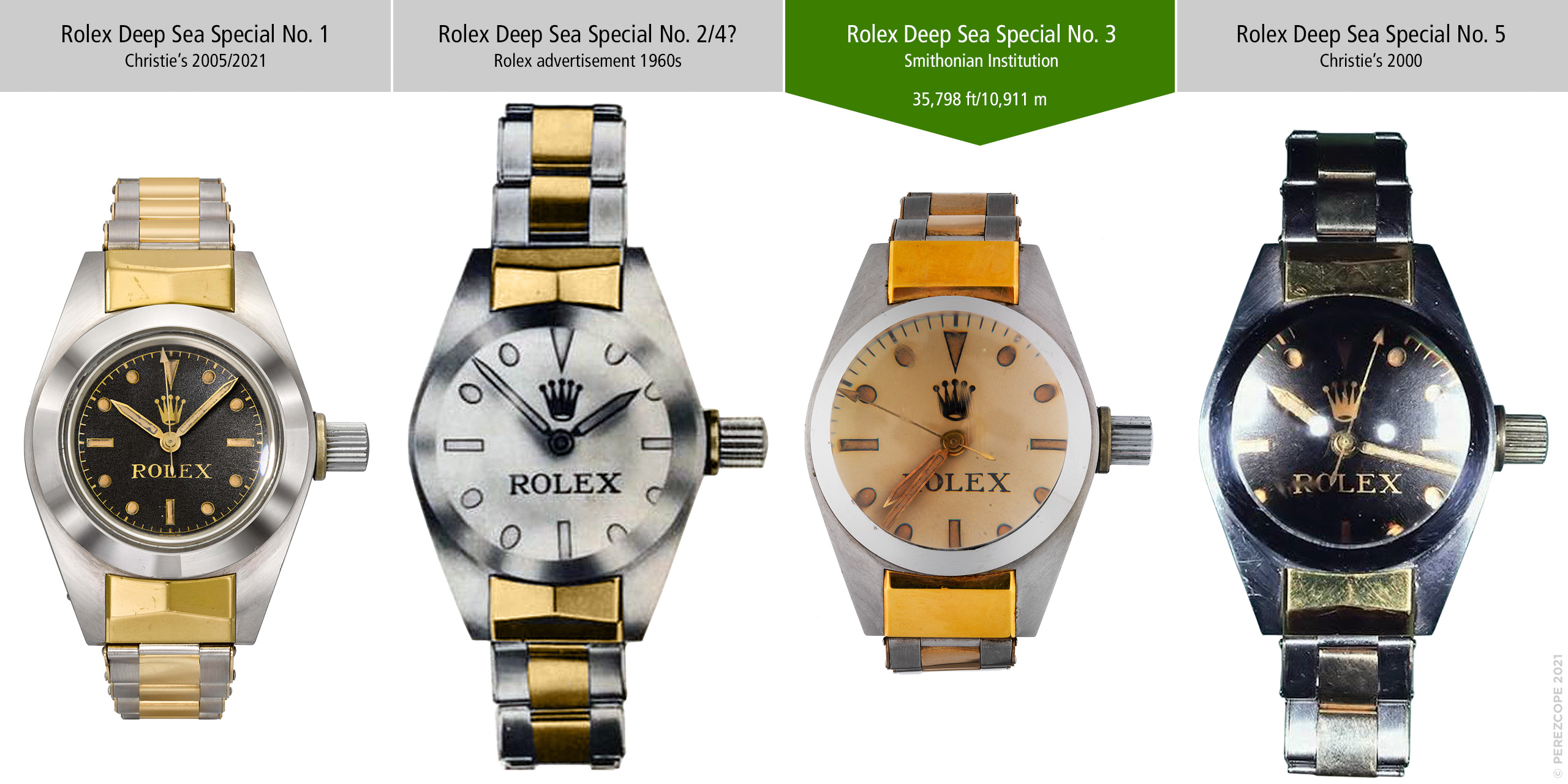
It is interesting to note that in 1953/54, Rolex did not refer to the ‘bathyscaphe’ watch as Deep Sea Special but just ‘Special Oyster’ or ‘Special Rolex’. The name Deep Sea Special was introduced for the last batch made between 1958 and 1960.
So what is the Deep Sea Special No. 1 in the end? It is not the 1953 record watch, that is for sure. The watch belongs, together with the DSS No. 3 from the Smithsonian and the DSS No. 5, to the last Deep Sea Special batch made after 1958 for the assault on ‘Challenger Deep’. But where Nr. 3 shows clear signs of wear and tear – even oxidation – something that can be expected from a watch that spent many hours in deep ocean water, No. 1 is in super pristine condition. But see for yourself.

To most insiders it is very clear the DSS No. 1 probably never got wet and these details seem to confirm this all too well.

The question is, why is the watch in such great condition except for the previously mentioned beaten up crystal?
Dented Crystal
The flat dents on the crystal edge are very interesting. How did this happen?

The thing is, it is physically almost impossible to accidentally dent the crystal there. This is best explained with the following illustration. The edge of the crystal is basically in a blind spot that cannot be hit by a flat object except if you purposely want to. But look what happens when the crystal is tall. The edge is completely exposed to such damages.

What to make of this? Well, it could be an indication that the crystal of the DSS No. 1 was tall at one point. Perhaps the height was reduced to make the watch more wearable. To conclude, let’s take another look at the comparison ‘real 1953 watch’ versus DSS No. 1.

The fact the real 1953 record watch had a taller crystal, as evidenced by the dial distortion, speaks volumes in my opinion.
Thoughts
When I did research for my Rolex Sea-Dweller timeline back in 2017, I came across the 1954 National Geographic ad and actually tried to digitally reconstruct that watch. I remember showing the results to a select group of vintage watch specialists but I was immediatelly laughed at. That is just a prehistoric rendering, some said. No it is not, it is a retouched photo of a watch that I am pretty, pretty sure resides at the Rolex archives in Geneva. Anyway, the general consensus was that the DSS No. 1 was the one and only record watch from 1953. They seemed to know what they were talking about so I went with the accepted narrative. I should have stuck to my guns.
On another note, it is a real shame that auction houses and most of the mainstream watch media do not research their subjects with the same precision the Swiss watch industry does their products. One particular incident is quite interesting. Hodinkee wrote in a recent article that a total of 35 commemorative Deep Sea Special pieces were made. A simple Google search would have revealed that at least 47 were made. Furthermore, the Hodinkees visited Beyer in Zurich who happens to own No. 36, a piece which was prominently featured in ‘Talking Watches’. So how did the number 35 come about? Well, RobbReport published the same nonsense a few days earlier. It certainly appears as if these “journalists” just copy from each other.
Thank you for your interest!

“Rolex took the opportunity to place one of their most iconic ads which celebrated the fact that Mount Everest and the ocean floor had been conquered in the very same year – 1953 – and that Rolex had been present at both events.”
Hmm. Rolex do all they can to imply that Sir Edmund Hillary wore a Rolex to the summit in 1953 but read that advert’s copy carefully. (Hillary was only wearing one watch, an English-made Smiths “De Luxe”.)
LikeLike
Some “fishy“ advertising then by Rolex ?
LikeLike
Very interesting and informative and very well written thank you.
LikeLike
Excellent, thanks Jose. At some point I really would appreciate Rolex shedding some light on the different Deep-Sea Specials, would have saved me a lot of time. In their own timeline published in the 50th anniversary Rolex pamphlet (shown in the beginning of your text), the watch shown as the “1960 Deep Sea Special” cannot be the same one that was given to the National Museum of American History, Washington D.C. on September 8, 1960 (No. 3), which is clearly a bi-color version. On the other hand, I’ve always struggled with the fact that Rolex would have opted with a bi-color version for the real dives, when there are stainless steel versions as well (although I’ve only come across display models, like No. 30 (Lucerne) and 3 (Munich).
LikeLike